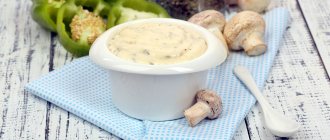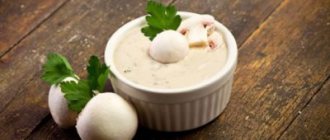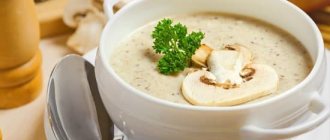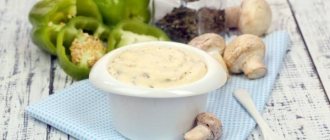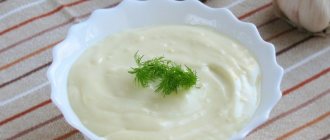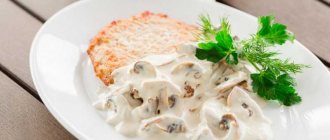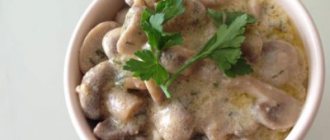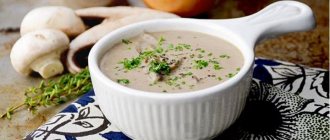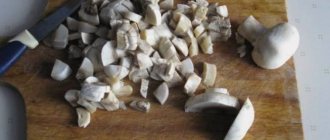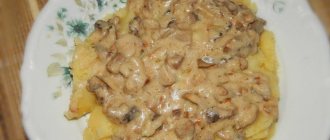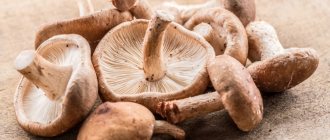The egg-shaped fly agaric has a special bright taste and a pleasant “sea” aroma. There are interesting culinary recipes, thanks to which you can appreciate its taste. If you come across this white mushroom in a clearing, do not pass by. Knowing a few simple secrets, you can prepare many delicious and original dishes.
What does an ovoid fly agaric look like?
Description of the ovoid fly agaric
Latin name Amanita ovoidea. The mushroom received the prefix “ovoid” for the shape of its young fruiting bodies, completely hidden under the cover.
Comment! In Crimea, the egg-shaped fly agaric in some areas is called white mountain fly by local residents.
But in other regions of Crimea, white mountain mushroom is called giant talker, so there may be confusion with the names and descriptions of mushrooms. It’s not worth buying such a white mountain one second-hand. In Crimea, everything that is white is collected for sale, including the stinking fly agaric.
The size of the fruiting bodies often depends on the weather and nutritional status of the soil. The average height is usually 10-15 cm. The cap and stem are white, but other mushrooms also have the same color. However, color can also vary. There are also darker varieties.
The pulp is white, dense, and does not darken when broken. The presence of odor most likely depends on the keenness of the mushroom picker’s sense of smell:
- poorly distinguishable;
- smells slightly of the sea;
- mealy, unpleasant.
The smell may depend on the place of growth. The taste is almost not noticeable.
Comment! The ovoid fly agaric is a lamellar mushroom, like all amanitaceae.
The spores are white, but they appear only on ripe fruiting bodies, which in any case are no longer suitable for food.
Comment! In the Krasnodar Territory, the species is listed in the Red Book.
Description of the cap
The diameter of a mature mushroom is from 6 to 20 cm. The cap of an old fly agaric is flat in shape with a bulge where the leg is attached from below.
Since at the beginning of growth the fruiting body is completely covered, it seems that the cap is integral with the stem, and the whole together has an ovoid shape. As it grows, the cover breaks. The upper part remains on the cap, and the lower part looks like a sepal of flowers, from which the stem grows.
As it grows, the cap takes on a rounded shape. The fringe left over from the torn volva (bedspread) is clearly visible at the edges. This is the main difference between the ovoid and its dangerous relatives. The skin can be white, off-white or soft beige. The hat is dry and shiny. A young fly agaric has sparse white flakes on it. The latter quickly disappear as the fruiting body of the ovoid fly agaric grows.
The hymenophore of young mushrooms is white. The plates are wide, free, with pubescent edges. In older ones, the hymenophores acquire a beige tint.
In aging mushrooms, the cap completely unfolds into a “saucer” with a bulge in the middle and may acquire a brownish tint. The remains of the Volvo at the edges almost disappear.
Description of the leg
The height reaches 10-15 cm and 3-5 cm in diameter. The consistency of the leg is dense, without voids inside. The shape is club-shaped: more massive at the bottom, thinner at the top. At the bottom there are remains of the bedspread. The color is white, yellowish or cream. The surface is not smooth. It is covered with a flaky powdery coating.
Description of Volva
Volva is large, semi-free, bag-shaped. The edge is lobed or wavy. Color usually comes in several options:
- whitish;
- yellowish;
- with a brown tint;
- light orange.
The ring on the stem is membranous, hanging, wide. White color. The remnants of the cover on the cap look like warty, sparse white flakes. They quickly disappear with age. At the edges of the cap there is a fringe of fibrous remains of the bedspread.
Comment! In almost mature fly agaric mushrooms, the volva along the edges of the cap may be absent.
Interesting Facts
- In some regions, the fly agaric ovoid is listed in the Red Book.
- The mushroom contains a small amount of neurotoxins that are neutralized by heat treatment.
- Along with Caesar's fly agaric, it is a delicacy in some countries.
The fly agaric ovoid, although edible, is fraught with many dangers - for example, there is a high chance of confusing it with other, more poisonous relatives. It is better to avoid unfamiliar or unfamiliar mushrooms - health is more valuable than delicacies.
Information sources
- Wasser S.P. Flora of mushrooms of Ukraine. Amanital mushrooms / resp. ed. K. A. Kalamaes. — K.: “Naukova Dumka”, 1992
- Mushrooms: Directory / Transl. from Italian F. Dvin. — M.: “Astrel”, “AST”, 2001
- Udu J.
Mushrooms. Encyclopedia = Le grand livre des Champignons / trans. from fr. - M.: Astrel, AST, 2003
Where and how does it grow
The distribution area of the fungus on the Eurasian continent is quite large. It is most often found in the Mediterranean. Due to the similarity of the climate, the ovoid fly agaric is one of the most common mushrooms in Crimea. Found in the British Isles, Central Europe, Transcaucasia, Western Siberia, and Japan.
Amanita ovata prefers limestone soils. For this reason, it is one of the most common mushrooms in the Crimean Mountains, composed of sedimentary limestone rocks. This species does not grow in too dry steppes, preferring more humid and shady deciduous and coniferous forests. But in Crimea, the ovoid is also found in the Bakhchisarai region.
Comment! Pines in Crimea are almost all planted artificially, and fly agaric is rare there.
Prefers to grow in forests of beech trees: chestnut, beech, oak.
True, there are no chestnut forests in Crimea. The growing season is August-September.
Links
- Taxonomy at www.mycobank.org
- Dr. Rodham E. Tulloss. Amanita ovoidea
(English). Retrieved September 22, 2009. Archived April 8, 2012.
This page was last edited on October 22, 2018 at 08:24. Material from Cyclopedia Jump to: navigation, search
Fly agaric ovoid
Taxonomy
Scientific classification
| Domain | Eukaryotes |
| Kingdom | Mushrooms |
| Sub-kingdom | Higher mushrooms |
| Department | Basidiomycetes |
| Class | Agaricomycetes |
| Order | Champignon |
| Family | Fly agaric |
| Genus | fly agaric |
| View | Fly agaric ovoid |
International scientific name Amanita ovoidea
(Bull.) Link 1833
Taxonomy on Wikispecies Images on Wikimedia Commons
EOL
(1029997)
| Mycological characteristics: |
| hymenium type: lamellar |
| cap: convex |
| hymenophore: free |
| leg: with ring and volvo |
| spore powder: white |
| ecology: mycorrhiza-former |
| Edibility: edible , not recommended for consumption |
Fly agaric ovoid
(lat.
Amanita ovoidea
) is an edible mushroom from the genus Amanita (
Amanita
) of the Amanitaceae
family
.
Is the mushroom edible or not?
You can eat conditionally edible mushrooms, but after some preparatory steps. However, in the ovoid fly agaric these procedures are kept to a minimum.
This mushroom does not need to be pre-soaked in several waters; simply boil it and drain the liquid. After this, you can prepare any dish from fly agarics.
When preparing for the winter, fresh egg-shaped fly agarics are dried or frozen. To marinate, they are first boiled.
In winter, dried fly agarics are first soaked in water and then boiled in the same way as fresh ones. Cooking frozen ones differs only in that they do not need to be soaked, but defrosted.
Attention! Today, the edibility of the ovoid fly agaric is in doubt, as several cases of poisoning by these mushrooms have been recorded.
But the outcome of the poisoning is unknown, and the type of mushrooms was most likely recorded from the words of the victims. In the same area, other deadly poisonous species can grow along with the ovoid one.
Reproduction
Like other mushrooms, fly agarics reproduce by spores. In the ovoid type, the spores are round in shape and colorless. Sometimes the color of the spore powder is white or pink.
A feature of this type of fly agaric spores is their vitality. They retain the ability to reproduce for several decades.
This is what mushroom spores look like
The distribution area is determined by several hundred kilometers. Spores are spread in water, through the air and by animals. When exposed to favorable conditions, they form mycelium and a new mycelium appears.
How to cook egg-shaped fly agarics
After boiling, you can prepare the same dishes with the egg-shaped fly agaric as with other mushrooms:
- sandwich or hot sandwich;
- salad;
- second courses;
- soup.
The main requirement when cooking is preliminary boiling.
Sandwiches
To prepare sandwiches, boiled fly agarics are fried in sunflower oil. Add onion, salt and pepper to taste. Fried mushrooms are mixed with finely chopped boiled eggs, parsley and chopped nuts are added. Grease the bread with butter and spread the resulting mass on it.
For hot sandwiches, place a plate of melting cheese on top of the resulting structure and place the plate in the microwave/oven. Once the cheese has melted, the sandwich is ready to eat.
Roast chicken
Roast chicken is more difficult to prepare. From the dishes you will need a pot, a pan for cooking mushrooms and a frying pan. Products you will need:
- 12 medium-sized ovoid fly agarics;
- 1 chicken breast;
- 1 carrot;
- 5 medium-sized potatoes;
- 1 onion;
- 50 g 20 percent sour cream;
- 5 tbsp. l. vegetable oil;
- a bunch of parsley;
- salt and pepper to taste.
The mushrooms are checked for spoilage and worms and washed. Cut into 4 parts, place in cold water and bring to a strong boil. The still bubbling broth is drained. But there is no need to start all over again. The second time the fly agarics are poured with hot water. Cook for 30 minutes or more until all the pieces sink to the bottom of the pan. Place in a colander to drain excess liquid. While the mushrooms are cooling, you can prepare the chicken breast.
The fillet is cut into thin strips and fried in a frying pan until golden brown. Transfer to a pot.
Mushrooms are fried in vegetable oil until excess water evaporates. The onion, cut into rings, is added to the fly agarics and fried until it softens. Transfer everything to the meat.
Peeled potatoes are cut into several pieces. The carrots are chopped into strips or grated on a coarse grater. Root vegetables are fried in a frying pan with a little oil for 5 minutes.
Vegetables are also placed in a pot, sour cream, pepper and salt are added. Simmer in a preheated oven until the potatoes are ready. This will take about 45 minutes.
Comment! Roast can also be made in winter from dried fly agaric mushrooms.
Salad with seafood and fly agarics
This salad is not difficult to prepare, but not all the ingredients may be on hand in a provincial town. For the salad you will need:
- mussels;
- fly agarics;
- celery root;
- sweet potato tuber;
- soy sauce or mayonnaise.
The mussels are baked in the oven for 5 minutes. Amanitas are boiled separately, the water is drained, cooled and chopped into layers. One medium sweet potato tuber and celery root are cut into thin strips. The almost finished dish is seasoned with mayonnaise or sauce and mixed thoroughly.
Comment! Egg-shaped fly agarics easily replace champignons.
Taste assessment, primary processing and cooking recipes
Despite the fact that the mushroom is classified as conditionally edible, its collection and preparation must be approached very carefully. Due to its close resemblance to some very poisonous fruits, it is better to avoid it, especially for novice mushroom pickers.
IMPORTANT! When collecting fly agaric, you do not need to cut it off, but twist the stem out of the ground. This does not harm the mycelium (the main body of the mushroom) and allows it to remain intact.
The taste of cooked egg-shaped fly agarics is a little specific and not everyone likes it. Some people are afraid of the name alone, since in Russia fly agarics, like edible mushrooms, are almost unknown to a wide circle.
Before the main preparation, the fruits must be trimmed from the edge of the stem, making sure that there are no fungal pests - worms. The stem and cap, clean from wormholes, are washed under running water to remove forest debris and soil. Next, the fly agarics are cut and boiled twice for 10 minutes in different water. Then put it in a colander and let the water drain. After this, the main stage of preparation begins.
- Fly agaric sauce. Fry the flour in a frying pan until browned, add water until a homogeneous paste-like mass is obtained. The resulting mixture is salted, peppered, herbs are added to taste, then equal parts of mustard and sour cream. The mixture is cooked over very low heat to prevent the flour from burning. After the mixture boils lightly, ready-boiled mushrooms, previously finely chopped, are added to it. The sauce is served hot with potatoes, buckwheat porridge, and meat.
- Oriental fly agaric. The boiled mushroom is cut into small pieces (some fans do not boil it, but cook it immediately), and fry it in vegetable oil with salt and pepper. After the liquid has evaporated, add chopped tomato and onion half rings to the mushrooms. The dish is stewed for several minutes. If desired, add capers at the end.
You can even get poisoned by edible mushrooms, including the conditionally edible fly agarics. Some people develop an allergic reaction similar to symptoms of poisoning.
All fly agarics, including edible ones, contain weak toxins that affect the nervous system. If the heat treatment is insufficient, they can enter the human blood.
In addition, poisoning when consuming ovoid fly agaric can occur if the mushroom is not sufficiently washed to remove pathogenic microorganisms on its surface.
Doubles and their differences
Cases of poisoning by the ovoid fly agaric may be due to the fact that this species has only two edible counterparts: young champignons and puffballs. You can only confuse fruiting bodies whose veil has not yet been torn. If you cut a champignon, you will see its main difference from the ovoid fly agaric - the brown hymenophore. The raincoat has no plates at all. As soon as the fly agaric's cover breaks, it can no longer be confused with its edible twins.
The situation is worse with other, poisonous, species of Amanitidae. The ovoid fly agaric growing in the Crimea, neither in the photo nor in the forest, practically does not differ from its poisonous counterparts. In addition to the ovoid, in the Crimean forest you can find:
- spring toadstool;
- white grebe;
- pale grebe;
- fly agaric;
- steppe fly agaric.
All these species grow in the same place as the ovoid one. Only the steppe fly agaric differs in that it is found in the steppe and tolerates summer drought well.
Comment! “Grebe” is a common name for some mushrooms of the Amanitaceae family.
Spring grebe (Amanitaverna)
Synonyms for the name: spring fly agaric, white fly agaric. It begins to grow in the spring. The season lasts until the end of summer. Prefers to grow in the same places as the ovoid one.
The fruit body is more “graceful” in build. The cap usually reaches a diameter of no more than 10 cm. There are no rags of bedspread at the edges of the cap.
The leg is 7-12 cm high and thinner (0.7-2.5 cm) than that of the ovoid. At the top there is a wide ring of white color with fuzzy stripes. The Volva at the base fits tightly to the leg, but is not fused with it.
The pulp is almost odorless, with an unpleasant taste.
White grebe (Amanitavirosa)
She's a stinking fly agaric. It is not called that for nothing. This mushroom has an unpleasant chlorine smell. The diameter of the cap is up to 11 cm. The color is white or off-white. Dry skin is shiny, sticky, slimy.
The leg is high, like an ovoid. But the diameter is no more than 2 cm. Like the ovoid, the leg is covered with a flake-like coating. Tuberous at the base. The membranous ring quickly disappears, but fibrous bands or fragments may remain.
Volva is up to 3 cm wide, bag-shaped or cup-shaped. Free. Often buried in the soil.
Most common in the north of the temperate zone of Eurasia. It is also found in Crimea. Season from June to October. In time, this period completely overlaps the season of the ovoid fly agaric.
Pallid grebe (Amanitaphalloides)
It may seem that the pallid grebe does not look like the egg-shaped fly agaric. But it has a very wide variation in color: from almost white to dirty green. The clarified variation can be confused with the edible fly agaric.
The sizes of the pale grebe and the ovoid fly agaric are the same. The latter is distinguished by a characteristic wide fringed ring on the stem. It disappears with age, but old mushrooms acquire an unpleasant sweetish odor, which is almost unnoticeable in young fruiting bodies.
The season for the pallid grebe is late summer-autumn.
Comment! Most often, the pale toadstool is confused with champignon, green and greenish russula and floaters.
Yellow Pale Grebe (Amanitacitrina)
Other names:
- fly agaric;
- lemon fly agaric;
- yellow-green fly agaric.
The sizes of the caps and legs of the yellow grebe are almost completely identical to the ovoid one. The skin color of the cap can be almost white. Because of this, the yellow toadstool is confused with the ovoid fly agaric.
The ring on the stem is wide, smooth, sagging. Yellow color. Volva rooted to the base. The color varies from brownish to yellow-brown. In young mushrooms it can be almost white. The pulp has a characteristic smell of raw potatoes and an unpleasant taste.
The yellow grebe grows in forests of any type up to an altitude of 1400 m above sea level. Season from mid-August to late October. The peak of the growing season occurs in September.
Attention! Collecting this type of mushroom is not recommended, since sources of information cannot decide whether yellow toadstool is a conditionally edible or poisonous mushroom.
Steppe fly agaric (Amanitavittadinii)
The second name is “Vittadini fly agaric”. Some sources classify it as poisonous, others as conditionally edible. Although the sizes of the ovoid and steppe fly agaric are the same, it is still difficult to confuse them.
The steppe leg remains scaly until adulthood. The cap is bumpy and the tubercles do not disappear, as happens with the scales on the cap of the ovoid.
The double ring on the stalk is warty, wide, with a membranous edge.
Grows in the steppe zone and mixed forests. Found in artificial plantings. Season from April to October.
Attention! To accurately identify fly agaric mushrooms when collecting, you do not need to cut the mushrooms with a knife, but twist them out of the ground along with the Volvo.
What is the danger
The description and appearance of the mushroom are very similar to poisonous species, so novice mushroom pickers should be extremely careful. According to the image in mushroom maps, it can be confused with the pale toadstool, which can result in acute poisoning if consumed.
There is a danger of confusing this type of mushroom with other white fly agarics. White fruiting bodies also have other poisonous forms, including:
- The stinking fly agaric is a white toadstool. The poisoning is severe and can be fatal.
- Spring fly agaric is a toadstool-like poisonous mushroom. The symptoms of poisoning are the same as those of toadstool. The growing season is spring.
Spring fly agaric - a toadstool-like poisonous mushroom
Symptoms of poisoning, first aid
Mushroom poisoning is dangerous because it only appears several hours after the meal. In case of poisoning with toadstool, the first symptoms appear after 6-24 hours. In case of poisoning with other amanites, symptoms may appear even after 3 days.
During this time, the poison has time to be absorbed and begin its destructive work. Signs of poisoning:
- vomit;
- abdominal pain;
- diarrhea.
After 2 days everything goes away, but in another day the functions of the liver and kidneys will be completely impaired. And this is already irreversible. Therefore, if such symptoms appear, you should make sure that there have been no mushrooms in your diet in the last 3 days.
Comment! If the mushroom is not fatally poisonous, signs of poisoning appear immediately or several hours after eating.
In case of poisoning with muscarine, which contains amanite, symptoms appear 30-120 minutes after ingestion:
- heavy sweating;
- increased salivation;
- visual impairment;
- constriction of the pupils;
- diarrhea;
- vomit;
- bradycardia.
In severe poisoning, pulmonary edema and respiratory failure develop, followed by collapse.
First aid consists of flushing the gastrointestinal tract and calling an ambulance. Antidotes to muscarine are anticholinergics, one of which is atropine.
In case of poisoning with toadstool, anticholinergic drugs do not work. Other antidotes are needed to neutralize its poison.
In any case, if symptoms of poisoning appear, you should consult a doctor as soon as possible. If poisoned by pale grebe, internal organs will be damaged, but there is a chance of survival.
